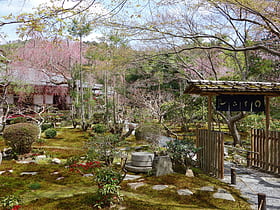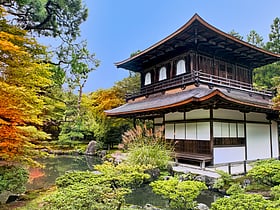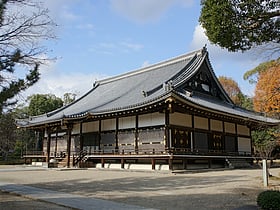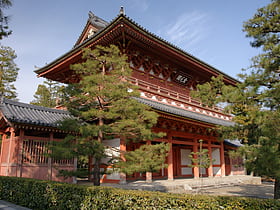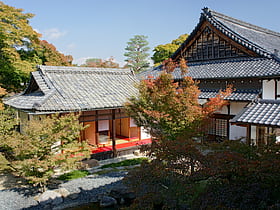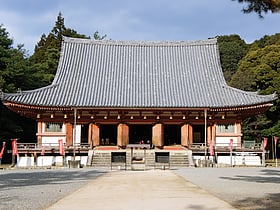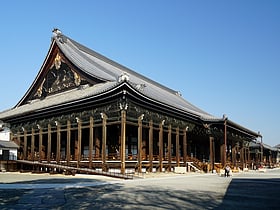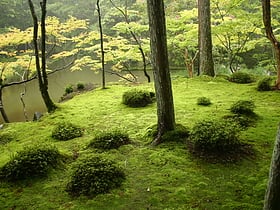Kyoto: Buddhist Temple
Places and attractions in the Buddhist temple category
Categories
- Temple
- Sacred and religious sites
- Buddhist architecture
- Buddhist temple
- Museum
- Historical place
- Park
- Unesco
- Garden
- Art museum
- Specialty museum
- Street
- Universities and schools
- History museum
- Palace
- Area
- Theater
- Concerts and shows
- Shopping
- Bridge
- Neighbourhood
- Sport venue
- Sport
Ryōan-ji
Long-standing temple with a Zen rock garden Ryōan-ji, located in the historic city of Kyoto, Japan, is an iconic Zen Buddhist temple known for its enigmatic rock garden, which attracts visitors from around the world. Established in 1450 during the Muromachi period, the temple belongs to the Myoshinji school of...
Ginkaku-ji
Enduring Zen temple with scenic gardens Ginkaku-ji, also known as the Silver Pavilion, is a historic temple that graces the cultural tapestry of Kyoto, Japan. This Zen temple, formally named Jishō-ji, was constructed in 1482 as a retirement villa for the shogun Ashikaga Yoshimasa, who intended to cover the...
Ninna-ji
Buddhist temple with scenic grounds Ninna-ji is a historic temple that stands as a beacon of cultural heritage in the ancient city of Kyoto, Japan. This revered site, founded in the year 888, is a quintessential representation of Japanese religious architecture and traditional aesthetics.
Daitoku-ji
Buddhist temple site known for gardens Nestled in the northern part of Kyoto, Daitoku-ji stands as a testament to the city's deep-rooted Zen Buddhist traditions. This sprawling temple complex, established in the 14th century, is not only a place of religious significance but also a serene park that offers a...
Tōfuku-ji
Scenic 13th-century Buddhist temple Tōfuku-ji, a Zen Buddhist temple, stands as a beacon of tranquility and historical significance in the culturally-rich city of Kyoto, Japan. Founded in 1236 during the Kamakura period, this temple is particularly renowned for its spectacular autumn foliage and the...
Tenryū-ji
Zen temple in a scenic, tranquil setting Tenryū-ji is a serene oasis nestled in the heart of Arashiyama, a scenic district on the western outskirts of Kyoto, Japan. Founded in 1339 by the shogun Ashikaga Takauji, this historic temple serves as the head temple of the Tenryū branch of Rinzai Zen Buddhism.
Sanjūsangen-dō
Sanjūsangen-dō, a revered temple situated in the heart of Kyoto, Japan, is a testament to the city's rich cultural and spiritual history. Established in 1164 and rebuilt in the 13th century after a fire, this temple is renowned for its impressive collection of...
Daigo-ji
Buddhist temple with gardens and a museum Daigo-ji, an ancient temple of profound historical significance, stands as a testament to the rich cultural heritage of Kyoto, Japan. Founded in the early Heian period, in 874, Daigo-ji is not merely a temple but an extensive complex that includes a pagoda, several...
Eikan-dō Zenrin-ji
Prominent Buddhist temple complex Eikan-dō Zenrin-ji, nestled amidst the vibrant hues of Kyoto's Higashiyama district, stands as a serene testament to the city's rich cultural and spiritual heritage. This historic temple, dating back to the Heian period, is a cornerstone of Japanese Pure Land Buddhism...
Daikaku-ji Temple
Buddhist temple with traditional gardens Daikaku-ji Temple is an emblem of serenity nestled in the ancient city of Kyoto, Japan. Established in the early Heian period, the temple originally served as a residence for Emperor Saga and was later converted into a Buddhist temple.
Kōdai-ji
Tranquil Buddhist temple with gardens Kōdai-ji, a serene Zen temple nestled in the heart of Kyoto, Japan, offers a tranquil escape from the hustle and bustle of the city. Founded in 1606 by Kita-no-Mandokoro in memory of her late husband, Toyotomi Hideyoshi, a prominent historical figure, the temple is a...
Kennin-ji
Buddhist temple with tea and a Zen garden Nestled in the heart of Kyoto, Japan, Kennin-ji stands as a serene testament to the city's rich Buddhist heritage. As the oldest Zen temple in Kyoto, this historical site offers a tranquil retreat from the bustling streets and a chance to immerse oneself in the...
Shōren-in
Shōren-in, a serene oasis nestled in the bustling city of Kyoto, Japan, is a historic temple that offers a tranquil retreat from the urban pace. Known for its intimate connection with the imperial family and its role as a residence for high-ranking monks, Shōren-in...
Higashi Hongan-ji
Buddhist temple with whimsical fountains Higashi Hongan-ji, or, ″the Eastern Monastery of the Original Vow″, is one of two dominant sub-sects of Shin Buddhism in Japan and abroad, the other being Nishi Honganji.
Chion-in
Grand circa-1618 Buddhist temple complex Chion-in in Higashiyama-ku, Kyoto, Japan is the headquarters of the Jōdo-shū founded by Hōnen, who proclaimed that sentient beings are reborn in Amida Buddha's Western Paradise by reciting the nembutsu, Amida Buddha's name.
Adashino Nenbutsu-ji
Temple known for its memorial statues Adashino Nenbutsu-ji is a Buddhist temple in Ukyo-ku, Kyoto, Japan. In 811 Kūkai is said to have founded a temple, then Honen altered it to the present Nenbutsuji.
Hōnen-in
Hōnen-in is a Buddhist temple located in Sakyō-ku, Kyoto, western Japan. Honen-in is a single-estate temple located in Shikagaya, Sakyo-ku, Kyoto. It was originally part of the Jodo sect, but became independent and is now a single religious corporation. Its official name is Zenkisan Honen-in Manmukyoji Temple.
Kurama-dera
Ancient temple in forested mountains Kurama-dera is a temple in the far north of Kyoto, Japan which houses some National Treasures of Japan. It was a member of the Tendai sect and subordinate to Shōren-in from the 12th century until 1949 when it founded its own religious body.
Shōkoku-ji
Shōkoku-ji, formally identified as Mannen-zan Shōkoku Shōten Zenji, is a Buddhist temple in northern Kyoto, first founded in 1382 by Ashikaga Yoshimitsu, with the existing temple complex having undergone several periods of extensive reconstruction and rebuilding in the succeeding eras.
Sanzen-in
Buddhist temple and picturesque garden Sanzen-in is a Tendai school monzeki temple in Ōhara, Kyoto, Japan. The Heian period triad of Amida Nyorai flanked by attendants is a National Treasure.
Shisen-dō
Historic Buddhist temple with gardens Shisen-dō is a Buddhist temple of the Sōtō Zen sect in Sakyō-ku, Kyoto, Japan. It is registered as a historic site of Japan. It stands on the grounds of its founder, the Edo period intellectual Ishikawa Jōzan, who established the temple in 1641.
Rokkaku-dō
The Rokkaku-dō, official name Chōhō-ji, is a Buddhist temple in Kyoto, Japan, said to have been established by Prince Shōtoku. The name comes from its main hall's hexagonal shape. This temple is part of the Saigoku Kannon Pilgrimage.
Otagi Nenbutsu-ji
Buddhist temple with sculpted heads Otagi Nenbutsu-ji is a Buddhist temple in the Arashiyama neighborhood of Kyoto, Japan. Otagi Nenbutsu-ji was founded by Empress Shōtoku in the middle of the eighth century. Though was destroyed by the flooding of the Kamo River, it was rebuilt as an offshoot of Enryaku-ji, a nearby temple.
Nishi Hongan-ji
Nishi Hongan-ji is a Jōdo Shinshū Buddhist temple in the Shimogyō ward of Kyoto, Japan. It serves as the head temple of the sub-sect Honganji-ha.
Shinsenen
Shinsenen is a Shingon Japanese Buddhist temple located south of Nijō Castle in the approximate center of the modern city of Kyoto, Honshu, Japan. It was founded by Kūkai in 824 and predominantly consists of a large water garden centering about a pond. It is said to be the oldest existing garden in Kyoto.
Saihō-ji
Buddhist temple with famed moss garden Saihō-ji is a Rinzai Zen Buddhist temple in Matsuo, Nishikyō Ward, Kyoto, Japan. The temple, which is famed for its moss garden, is commonly referred to as "Koke-dera", meaning "moss temple", while the formal name is "Kōinzan Saihō-ji".
Myōshin-ji
Temple complex with landscaped gardens Myōshin-ji is a temple complex in Kyoto, Japan, and head temple of the associated branch of Rinzai Zen Buddhism.
Daisen-in
Daisen-in is a sub-temple of Daitoku-ji, a temple of the Rinzai school of Zen in Buddhism, one of the five most important Zen temples of Kyoto. The name means "The Academy of the Great Immortals." Daisen-in was founded by the Zen priest Kogaku Sōkō, and was built between 1509 and 1513.
Mibu-dera
Mibu-dera is a Buddhist temple in Nakagyō-ku, Kyoto. In the Middle Ages, the temple revived a performance created by the Yuzu Nembutsu monk Engaku known as the Dai Nembutsu Kyōgen. It is also known for having been affiliated with the Shinsengumi.
Chishaku-in
Chishaku-in is a Buddhist temple in Higashiyama-ku, Kyoto, Japan. It is affiliated with Shingon-shū Chizan-ha Buddhism. It was established in 1601. The temple has a historic garden that was said to be a favourite of Sen no Rikyū.
Hōkō-ji
Hōkō-ji is a temple in Kyoto, Japan, dating from the 16th century. Toyotomi Hideyoshi determined that the capital city should have a Daibutsu temple to surpass that of Nara.
Konpuku-ji
Konpuku-ji is a Zen Buddhist temple in Sakyō-ku, Kyoto, Japan.
Myōan-ji
Myōan-ji is a Buddhist temple located in Kyoto, Japan. Myōan-ji is a sub-temple of Tōfuku-ji, and contained within the larger Tōfuku-ji temple complex, located in Higashiyama ward.
Jakko-in
Jakkoin is a temple of the Tendai sect in Ohara, Sakyo-ku, Kyoto. It is a nun temple. The name of the temple is Seikozan. The temple name is Gyokusenji. The main deity is Jizo Bosatsu. It is said to have been founded by Prince Shotoku.
Gangyō-ji
Gangyō-ji is a Buddhist temple in Kyoto, founded by the priest Henjō. The Emperor Kōkō endowed the temple and the emperor Kazan abdicated in this temple.
Ōbai-in
Ōbai-in is an autonomous sub-temple of Daitoku-ji, Kyoto, Japan, the headquarters of the Daitoku-ji school of the Rinzai sect of Zen Buddhism. The Hondō and Kuri have been designated Important Cultural Properties.
Tsukinowa-dera
Tsukinowa-dera or Gatsurin-ji is a Buddhist temple near Mount Atago in Ukyō-ku, Kyoto, Japan. The temple was first founded in 781, it is associated with the Shugendō practices of Kūya and Hōnen. Its treasures include eight Heian period statues.
Map

